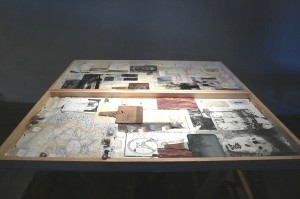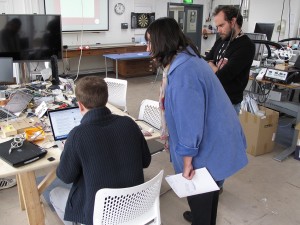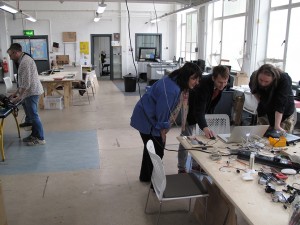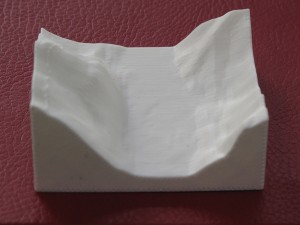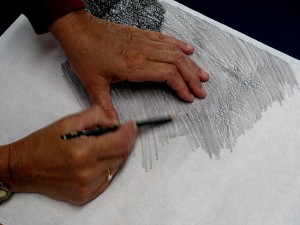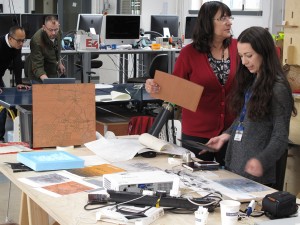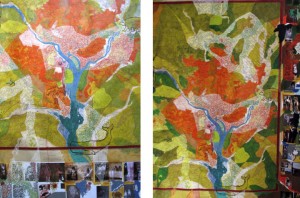

(Two detail shots from a work-in-progress provisionally called: An animist’s re-mapping of Washington and the vicinity)
“Looking up from dealing with the socks and you hear an oystercatcher – why should these things be separate”? Kathleen Jamie (from her public lecture: Poetry, the Land, and Nature)
Introduction
This essay is in part prompted by a visit to an international touring exhibition, currently at the P21 Gallery in London, called: “The Map is Not the Territory”: Parallel Paths – Palestinians, Native American, Irish and by reading the accompanying catalogue, edited by Jennifer Heath and published by Backsun Books & Arts for social and environmental justice in 2015. (My friend Nessa Cronin, who has contributed a chapter to this catalogue, alerted me to both it and the exhibition). But it is also concerned with the wider implications of the phrase ‘the map is not the territory’, particularly as these might apply to those of us who are engaged in cultural and educational work.
What follows is also prompted by a growing sense of discomfort at my own inability to address paintings within the scope of the writing I’m now doing, particularly those paintings I’ve long admired and been drawn to – works by Paula Rego, Ken Kiff, Andrzej Jackowski and Eileen Lawrence, for example. (This sense is partly because I referenced Paula Rego’s work in a talk for a conference on the Gothic in Limerick last year, which indicated that I’ve been neglecting a valuable resource). I want to find appropriate ways to think about paintings in the context of ecosophical praxis, but to date have largely been unable to do so. This now pushes me to try to find a more inclusive approach to writing. One that can respond openly and fluidly to what such work might show me about the continuous and particular exchanges and tensions within and between the fields of the psyche, the social, and the environment that constitute lifeworlds.
I think this requires developing a multi-stranded and openly narrative – as opposed to primarily analytic – style of writing. A narrative that is inclusive and stays open to the many interwoven strands of our lifeworld as polyverse, strands that are continually ravelling up and then and unravelling. I take this need to evoke a lifeworld as polyverse to be central now.
As James Hillman argued long ago, the ‘Monotheistic’ (or more simply ‘monolithic’) mentalité – the worldview that Enlightenment science inherited from the Religions of the Book – should not have survived the Holocaust. Yet it continues to dominate our culture. In one of the chapters in The Map is Not the Territory, Valerie Behiery draws attention to the cultural politics and economic power that makes it extraordinarily hard for an American curator to present a Palestinian cultural event in the USA. As she observes, any such attempt is faced – whether tacitly or directly – with accusations of being “anti-American and anti-Israeli propaganda and a glorification of terrorism and murder”. (p. 34) In a global mainstream culture still dominated by the presuppositions of ‘either-or’ thinking that is the most tenacious legacy of the monolithic mentalité, it is all too easy for a powerful coalition of Republican, Christian fundamentalist, and Jewish pro-Israel interests in the US to do this. This hides, along with much else, the fact that Zionist terrorism was central to the creation of the Israeli state. Lohamei Herut Israel (Lehi – otherwise called ‘the Stern gang’ after its founder, Avraham Stern), whose former leader Yitzhak Shamir became Israeli Prime Minister in 1983, openly operated on the basis of the assumption that: “Neither Jewish ethics nor Jewish tradition can disqualify terrorism as a means of combat”. (In He Khazit, an underground publication of Lehi, Issue 2, August 1943. No author is given, as was usual for this publication). So cultural threats enable a powerful political lobby to avoid addressing the question of why, if it was legitimate for Jews to use terrorism against the British in order to gain a homeland, Palestinians should not do the same. Particularly if they find themselves placed in a situation infinitely more oppressive than that faced by Lehi?
Yet in a ‘monoverse’ underwritten by the absolute dualism that ultimately flows from fundamentalist readings of the Religions of the Book, this question is not just irrelevant, it’s un-ask-able. In that monoverse, if you’re in America or Israel you are expected to be either for or against Israel. If you’re in a country where Isis or its equivalents are at large, you are expected to be either for or against a highly selective misreading of Islam. Two sides of the same coin, since in both instances there is nothing to consider beyond the playground question: “whose side are you on”? No room then, for the complexities of history, issues of common sense, a considerations of the millions now caught up in a murderous realpolitik, and certainly no room for compassion or fellow feeling. And this childish and ultimately murderous reductivism is, in the last analysis, the reality behind American support for Israel, behind Israel’s policy towards the Palestinians, and behind radical Islamic fundamentalism. The “them or us” question that cuts short all other, more nuanced, considerations.
So trying to think, write and otherwise act out of the reality of our living in a many-stranded polyverse is now, in my view, an absolute necessity. It gives us some purchase on the resources that allow us to resist the mentalité that continues to generate massive levels of socio-environmental destruction globally. In short, the old monolithic mappings we inherited are indeed not the territory. Indeed, their disinformation is now terminally toxic.
A day out
I went to London for three reasons: to see my brother, to visit the P21 exhibition, and to see Agnes Martin’s work on show at Tate Modern. I have had an ‘at-a-distance’ fascination with Martin’s work – I’d seen almost none other than in reproduction until my visit to London – that was first set in motion by Thomas McEvilley’s Gray Geese Descending: The Art of Agnes Martin. This was amplified by the Scottish artist Eileen Lawrence, who told me that two important influences on her work were encounters with the work of Joseph Beuys and Agnes Martin. Like Martin, Lawrence could so easily have said that she does not paint gray geese, but “the emotions we have when we feel gray geese descending” (quoted in McEvilley 1993, p. 71). (If I was asked to illustrate the chronic cultural provincialism of the Tate, it’s abject failure to properly represent British art in all its richness and complexity, I would point to its shamefully neglect of Lawrence’s extraordinary work, of which it owns a single example. Is it any wonder that so many Scots want their independence)?
Given the very different reasons behind my three excursions, I had no expectation that my day in London would develop any kind of coherence beyond doing what I’d set out to do, but this essay is an attempt to give some account of just such coherence.
At the P21 gallery
I had agreed to meet my brother at the P21 Gallery at 11.30 but it was still closed when I arrived late – I’d neglected to discover that it does not open until 12.00 – and, just as I found it, he phoned to say he too was running late. I enquired from the office below the gallery when it would open. Very shortly, I was told, and at once invited to sit and wait there until it did. The young man whose work I’d interrupted was both courteous and inquiring, asking almost at once what I made of the Palestinian situation. I quickly sensed that in this place a hospitable courtesy, political awareness and cultural curiosity were seamlessly joined. This impression was confirmed when I was taken up into the gallery foyer. I was immediately thanked for coming to see the exhibition, with thanks followed by further enquires as to my reasons for doing so as my guide busied himself with the rituals of opening a gallery. After a little while, when alarms had been disarmed and doors unlocked, I got to see some of the work. (Some I did not. It was in a downstairs room and my brother, who needed to catch a train after meeting me, had gone to another address. I could only buy a copy of the catalogue and go to the British Library to meet him).
What I saw at P21 was interesting in a variety of ways. One image of many that stays with me is Najat El-Taji El-Khairy’s The Rock of Palestine in Basel. This depicts a small island of rock in the shape of Palestine, situated just off the bank of the Rhine in Basel. There is an almost hallucinogenic sadness in the conjunction of the title and image, something amplified further by the artist’s comment that: “My land follows me everywhere … Ironic, isn’t it? To discover this little rock, shaped like the map of Palestine right were the First Zionist Congress took place in 1897, the first step in the condemnation of our people to suffering, injustice and oppression”. (p. 58). This rich and nuanced interplay of image and text, and of carefully located personal experience – this insignificant rock was discovered on a stroll with the artist’s three-year-old grandson along Sankt Alban-Rheinweg Street – with imaginative reverie, historical knowledge and the political, is indicative of the way in which the exhibition avoids a crude polemic and offers instead ways of addressing, in a number of dimensions, what John Halaka acknowledges – alongside the multiple needs for restorative justice – is the necessity of recognizing that what has been inflicted means that Palestinians “can never recreate their shattered past or reset the hands of time”. (p. 72) An observation that, although in far less extreme circumstances and with less drastic effects, constitutes an aspect of our common reality. By inviting our cognizance of that fact, the exhibition points up grounds for human solidarity rarely acknowledged by work in this vein.
In one sense, however, the exhibition had done its work even before I set eyes on it. It had created a vivid occasion for openness, for exchange, and in doing so expanded my existing felt understanding of the dynamics of a complex, conversational relationship. That conversational relationship – in which I was already a minor participant through exchanges with one of the catalogue/book’s authors, Nessa Cronin – is now woven into, and so challenges me to remember and reconsider, my existing connections to the people whose lifeworlds find echoes in this exhibition. To the Palestinian artist Alexandra Handal (alexandrahandal.org/), to my friend Mona M. Smith, a Sisseton-Wahpeton Dakota media artist, educator and the owner of Allies: media/art , and to a widening and heterogeneous group of friends and colleagues in Ireland – perhaps in particular Nessa Cronin, Deirdre O’Mahony, Cathy Fitzgerald, Pauline O’Connell, and some of (the staff at Limerick College of Art and Design. But also to the painter Samira Abbassy (born in Ahwaz, Iran, but now resident in New York) who, coincidentally, currently has a show of complementary work in London, entitled Love & Ammunition.
All of which is really only to say that cultural experience is never either wholly aesthetic or disinterested. It is always at some level bound up with lives, with friendships (and enmities), with all the textures and trajectories of lived experience. This is, I think, what I have been trying to find ways to reflect in my writing.
Much of the work on view in the exhibition consists, inevitably in the circumstances, of reproductions of work too large or costly to transport, an obvious and striking example of this necessity being the small print of Hani Zurob’s large painting Flying Lesson no. 04. Zurob’s approach in this and other works in the series is indicative of that presented in much of other work. It flows from a question asked by his young son Qoudsi as to why his father cannot travel with his family to Jerusalem. The painting, which shows the tiny figure of Qoudsi in his toy car contrasted with the almost surreal nature of the suspended apparatus by which one enters and exits aircraft, evokes space and distance in the context of the fragility of love rather than any overt sense of political message. And is all the more eloquent for doing so. Michele Horrigan, a photographic artist, evokes something similar in her images of abandoned houses in Leitrim, one of the poorest areas of rural Ireland. This is representative of a whole body of powerful Irish work, another example being Deirdre O’Mahony’s Abandoned Clare series, a collection of 54 photographs that also exists as a free magazine, Abridged 0 – 20: Abandoned Clare .
There is much more than could be said about the various works on show, but ultimately what I took from the exhibition was a powerful sense of a collective attempt to map the un-map-able (an attempt that, in line with George Steiner’s take on the translation of poetry, is both impossible and vital if we are to avoid living in “arrogant [and indeed murderous] parishes bordered by silence”). A form of collective deep mapping of the absences that haunt diaspora and the events that give rise to it, and of the savage indifference to the basic human need to place ourselves and have a sense of being ‘at home’ in the world, to say the least. (Although, as Deirdre O’Mahony has reminded me in the course of a long and fascinating conversation in Galway, for some our ‘at-home-ness’ may need to be other than literal).
In all this I am also somewhat uncomfortably aware that, historically speaking, my people are implicated in what the dedication to the book refers to as the desecration, by “invasion, occupation and colonization”, of their “lands, cultures and ecologies”. I may have some direct experience of the powerlessness that haunts the situations to which the P21 exhibition artists refer. (The result of our many years of dealing with the authorities that seek to dictate just what can and cannot happen to my chronically sick daughter). But this cannot give me more that a distant glimpse of lifeworlds largely framed by such desecration.
On the play of differences and similarities
My brief exchange about Ireland during the opening up of P21 reinforced something of the sense of commonality shared by the Irish, Palestinians and Native Americans that the exhibition addresses and the book elaborates. However, my academic habits are such that my thinking quickly turned to differences. I found myself noting that, whatever the strengths of those commonalities, there are significant differences between the situations of each. But this way of thinking is, I suspect, an evasion of something more important. Jennifer Heath begins the book by reminding us of this by using a quotation from Immanuel Wallerstein: “We can always pinpoint difference, it is the easiest of all scholarly tasks, since everything is always different in some ways from everything else across time and space. What is harder and takes priority is to discover similarities”. It is, after all, on similarities that we can best start to built a sense of common human solidarity and compassion for all beings, human and otherwise.
Wallerstein’s observation is, I think, a profoundly challenging one. Much of the contemporary academic and cultural enterprise is based on an education that provides students with analytic tools designed to highlight difference. This is another byproduct of the dominance of the monolithic mentalité. It seems to me that there is now an urgent need to modify those tools and to re-orient their use, perhaps taking as a guideline Paul Ricoeur’s notion of a philosophy of ‘critical solicitude’. Education too is, arguably, a mapping or re-mapping exercise of sorts and, as Nessa Cronin very rightly reminds us in her book chapter, the authority of any mapping exercise always needs to be put in question, even where such a mapping is bent on “revealing, authenticating, and legitimizing a previously silenced history” (p. 95). What is essential, however, is that due consideration or solicitude is given to the lived experience and historical context that informs such mappings. It is then possible for contestation to become a conversation rather than an argument based on a taking up of monolithic positions.
That four letter word – ‘love’
As my friend the artist and academic Mary Modeen has pointed out, to speak of ‘love’ in the context of academic work is to question a taboo. In a paper given at a PLaCE symposium in Bristol in 2011”, she said:
“To those of us who are academics … love is a four-letter word. It is immeasurable and therefore by its very nature outside academic territory. It cannot be calculated, predicted or even adequately defined except perhaps normatively, as enacted by individuals, new in its manifestation each and every time. Even though it is as old as humans themselves, probably predating that which we know as human, shared (we are certain) by many fellow creatures in the animal kingdom, and known as well as ‘the force that through the green fuse that drives the flower’, it is not academic properly speaking, not to be trusted, best avoided for other less risky terms. And yet…it is the best word I can think of to discuss the ways in which we interact with our environment.”
Topophilia (the love of place) tends to be regarded with considerable suspicion in academic and cultural circles. It is (often quite correctly) seen as a smiling mask that hides exclusionary nationalistic and other xenophobic sentiments. But as Mary Modeen and, more recently, George Mombiot remind us, it is a fundamental aspect of our relationship to the world. Loving relationships to place, however understood, are in some sense essential to our wellbeing and, in the context of the present eco-social situation, also very possibly to our future survival. It is senses of this that permeates the more interesting work in the P21 gallery and, as a result, makes it possible for me to write this essay.
In a text reproduced in the catalogue to the Tate Modern’s Agnes Martin exhibition, Martin ponders matters of beauty and happiness (pp. 158-9) However, I think that in her writing about beauty “as an awareness in the mind” she comes close to evoking what I would call ‘a loving attention to the world’. I can offer no hard and fast definition of what I mean by this phrase. Instead I invoke a statement by the poet and essayist Kathleen Jamie. When asked by a friend if she had prayed for her chronically sick partner when he was in hospital, she said she’d not. She adds, however, that she: “… had noticed, more than noticed, the cobwebs, and the shoaling light, and the way the doctor listened, and the flecked tweed of her skirt, and the speckled bird and the sickle-cell man’s slim feet. Isn’t that a kind of prayer? The care and maintenance of the web of our noticing, the paying heed. ” (Kathleen Jamie Findings 2005, p. 109).
It’s a sense of this “care and maintenance of the web of our noticing”, of “paying heed”, that I detect behind Agnes Martin’s statements and, more directly, as present in some of her work. And it’s resistance to the socio-political denial of any normal or familial context for such care and maintenance, such paying heed, that I sense unites many of the artists in the P21 exhibition. A shorthand term for this cruelly denied quality is, of course, the exercise of love. In short, one of the experiences that has been and/or is denied to the Palestinians, the Native Americans and the Irish by the cruelties of their historical situation, is an important aspect of the fundamental human need to exercise that capacity to love in its fullest sense. A specific form of love that primarily takes part in, and with the aid of, familiar or familial, places, with the ability to ‘be-at-home’ somewhere.
The relationship between this situation and some of Agnes Martin’s work is powerfully evoked by four works in the exhibition: two works from 1963 – Friendship and A Grey Stone – White Stone from 1965, and Untitled 12 from 1984. What I experienced as uniting these (and what links them to the twelve paintings in The Islands series of 1979 that forms the centrepiece of the exhibition) is that loving, attentive and care-filled engagement with the ineffable hæcceity or inscape (to borrow the poet Gerard Manley Hopkins’ term) of a particular ‘homely’ landscape. Agnes Martin’s term for what is produced by this engagement is ‘joy’. Looking at these paintings I can recognise the joy that, for example, accompanies the revelation of the connection between transient beauty and our mortality that occurs when the drifting shadows of small clouds move over the land landscape on a sunny day (White Stone). Or when my eye is absorbed in the mottle and granulation of a stone (Untitled 12 and A Grey Stone). In these works there is a palpable sense of loving attention transmuted into a cooly distilled painterly image that I find intensely moving. But for me the key work, perhaps because of its affinities to works by Eileen Lawrence that it may or may not have influenced, is Friendship. Here a rich, warm red under-painting shows through the incised gold leaf. The result is an icon without explicit subject or inflection, an evocation of the immanent, sensual warmth of … what? Of warm desert earth, of sunlight, of joy? I don’t and cannot know. But I am as certain as I can be that the memory of what it is that this painting evokes, and what has been done to deny the Irish, Native Americans and Palestinians certain fundamental human needs associated with that, is what the work at P21 speaks of..
George Mombiot, whose article The Pope can see what many atheist greens will not (Guardian June 17th 2015 I read on the train on my way to London, quotes Michael McCarthy on the need for a certain closeness to nature, on our capacity to be “surprised by joy”. In terms Agnes Martin might have recognised, he quotes McCarthy’s reference to: “A happiness with an overtone of something more, which we might term an elevated or, indeed, a spiritual quality”. He goes on to put his finger on the question that I think the P21 exhibition tries to address. “If the acknowledgement of love becomes the means by which we inspire environmentalism” – or indeed any other form of eco-social responsibility – in others, how do we translate it into political change”?
I am wagering here that one why to answer to Mombiot’s question is to better understand what is necessary to acts of translation. As I’ve indicated elsewhere, I think this can be linked to forms of collective deep mapping to which Nessa Cronin refers towards the end of her chapter. These help us to maintain a fluid and open engagement with place, encouraging us to narrate and evoke it in all its temporal depth and ambiguity. Also to honour shifting connectivities and conversations between multiple voices, all against the background of an ethics that asks that we seek to live the good life, with and for others (including non-human others), in just institutions and environments.

